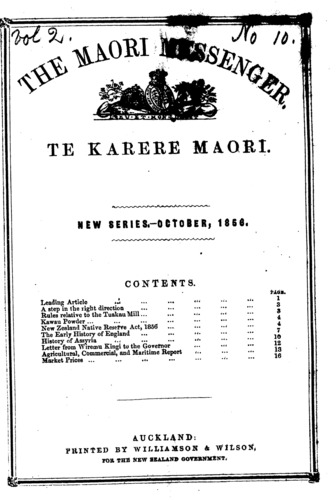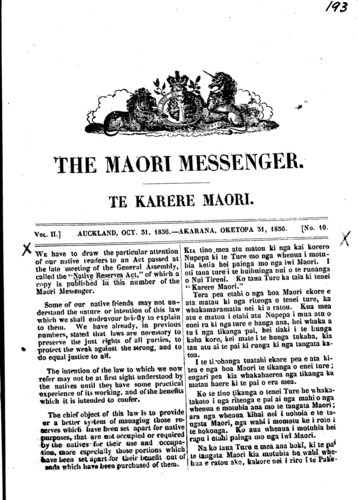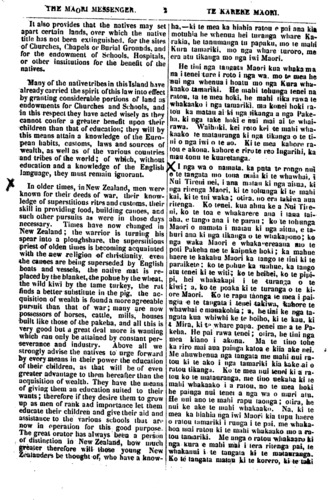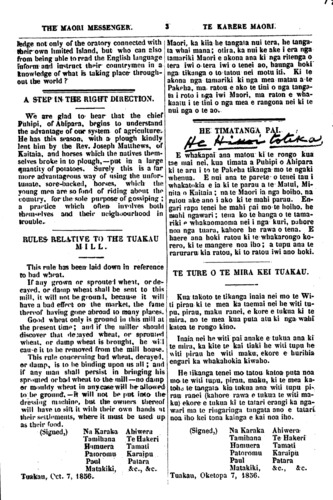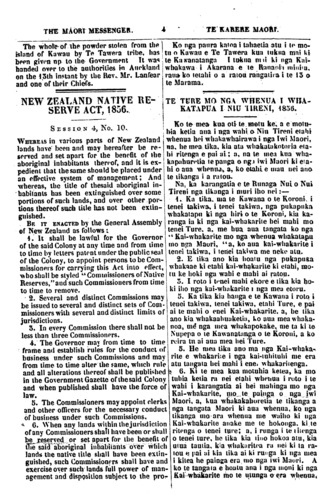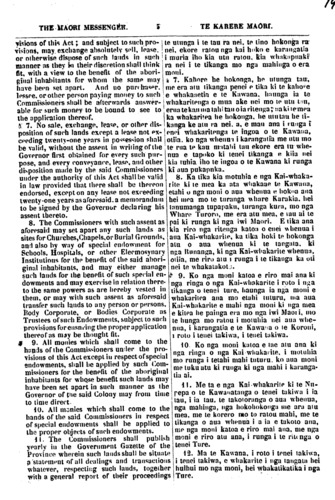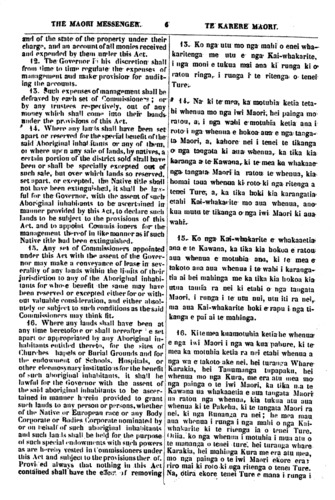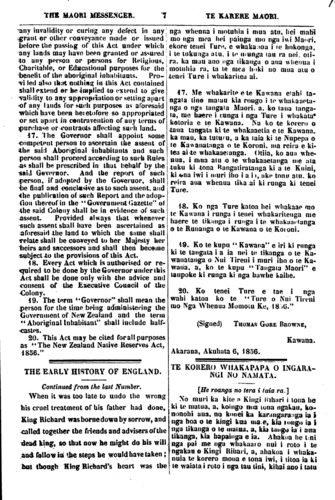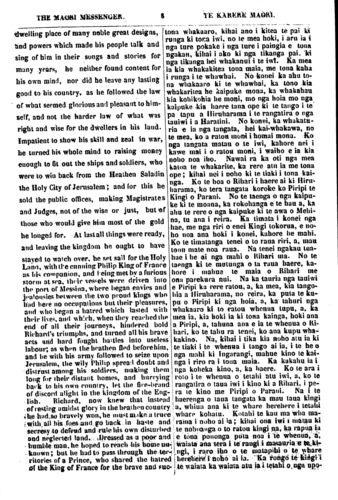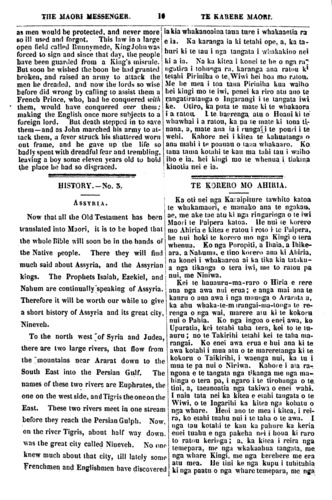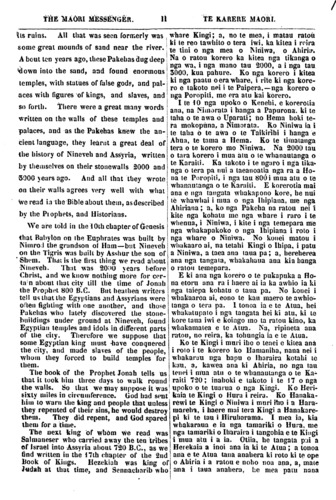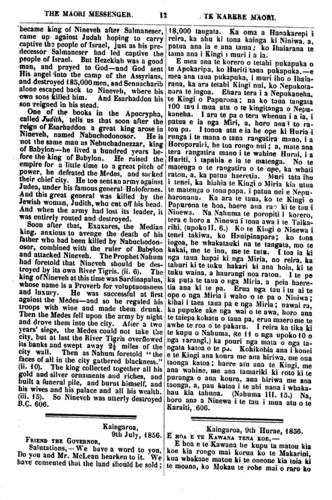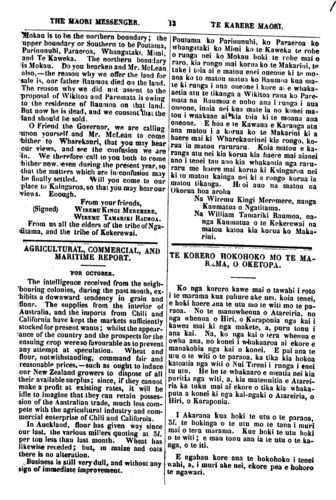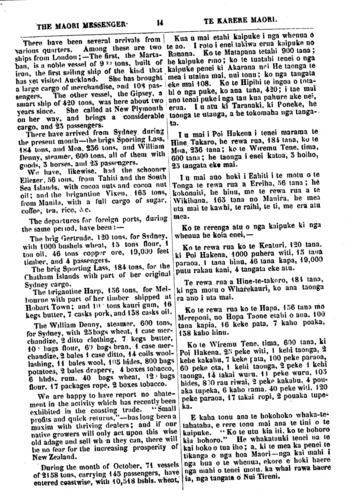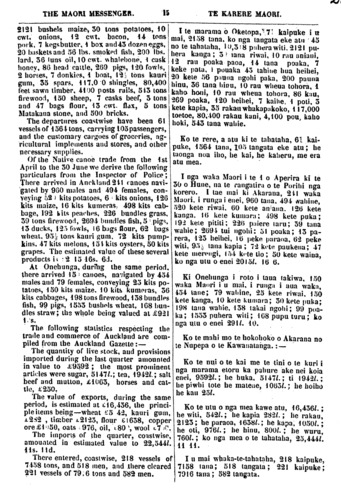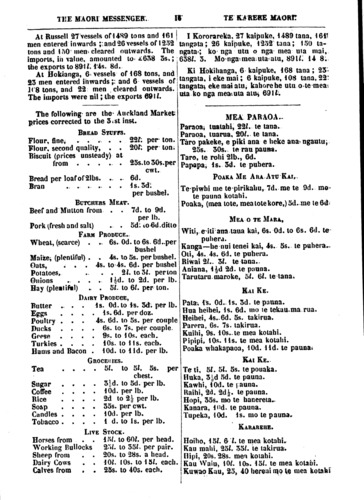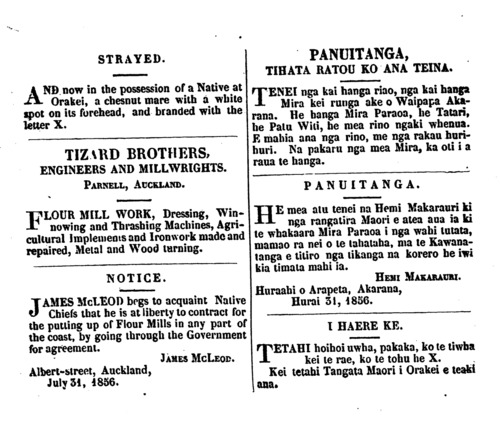The Maori Messenger - Ko te Karere Maori 1855-1860: Volume 2, Number 10. 31 October 1856
 |
The Maori Messenger - Ko te Karere Maori 1855-1860: Volume 2, Number 10. 31 October 1856 |
 |
1 0 |
▲back to top |
TE KARERE MAORI. NEW SERIES-OCTOBER, 1856 CONTENTS. Page: Leading Article 1 A step in the right direction . ... 3 Rules relative to the Tuakau Mill. . 9 Kawau Powder... ... . ... 4 New Zealand Native Reserve Act, 1856 . . 4 The Early History of England . . 7 History of Assyria ....* . . 10 Letter from Wiremu Kingi to the Governor . . 12 Agricultural, Commercial» and Maritime Report . . 13 Market Prices ... ... . ... . . 16 AUCKLAND: PRINTED BY WILLIAMSON & WlLSON FOR THE NEW ZEALAND GOVERNMENT,
 |
2 1 |
▲back to top |
THE MAORI MESSENGER. TE KARERE MAORI. VOL. 11.] AUCKLAND, OCT. 31, 1836. AKARANA, OKETOPA 51, 1856. [No. 10 WE have to draw the particular particular attention of ourour native readers to an Act passed at the late meeting of thethe General Assembly, called the "Native"Native ReservesReserves Act," of which a copy is publishedpublished in this number of the MaoriMaori Messenger. Some of our native friends may not un- derstand the nature or intention of this law which we shall endeavour briefly to explain to them. We have already, in previous numbers, stated that laws are necessary to preserve the just rights of all parties, to protect the weak against the strong, and to to equal justice to all. The intention of the law to which we now refer may not be at first sight understood by the natives until they have some practical experience of its working, and or the benefits which it is intended to confer. The chief object of this law is to provide or a better system of managing those re- serves which have been set apart for native purposes, that are not occupied or required by the natives for their use and occupa- tion more especially those portions which have been set apart for their benefit out of and which have been pur chased of them, KIA tino. mea atu matou ki nga kai korero Nupepa ki te Ture mo nga whenua i motu- hia ketia hei painga mo nga iwi Maori. I oti taua ture i te huihuinga nui o te runanga o Nui Tireni. Ko taua Ture ka taia ki tenei "Karere Maori." Tera pea etahi o nga hoa Maori ekore e ata matau ki nga ritenga o tenei ture, ka whakamaramatia nei ki a ratou. Kua mea atu e matou i etahi atu Nupepa i mua atu o enei ra ki nga ture e hanga ana, hei whaka a tu i nga Ukanga pai, hei tiaki i te hunga kaha kore, kei male i te hunga tukaha, kia tau atu ai te pai ki ranga ki nga tangata ka- toa. I te tirohanga tuatahi ekore pea e ata ki- tea e nga hoa Maori te Ukanga o enei ture; engari pea kia whakahaerea nga tikanga ka matau haere ki te pai o era mea. Ko te tino Ukanga o tenei Ture he whaka- takoto i nga ritenga e pai ai nga mahi o nga whenua e motuhia ana mo te tangata Maori; ara nga whenua kihai nei i nohoia e te ta- ngata Maori, nga wahi i momotu ke i roto i te hokonga. Ko aua whenua i motuhia hei rapu i etahi painga mo nga iwi Maori. Na ko taua Ture e mea ana hoki, ki te pai te tangata Maori kia motuhia he wahi whe- nua e ratou ako, kahore nei i riro i te Pake-
 |
3 2 |
▲back to top |
TE KAREKE MAORI. It also provides that the natives may set apart certain lands, over which the native title has not been extinguished. for the sites of Churchcs, Chapels or Burial Grounds, and for the endowment of Schools, Hospitals, or other institutions for the benefit, or the natives. Many or the native tribes in this Island have already carried the spirit of this law into effect by granting considerable portions of land as endowments for Churches and Schools, and in this respect they have acted wisely as they cannot confer a greater benefit upon their children than that of education; they will by this means attain a knowledge of the Euro- pean habits, customs laws and sources or wealth) as well as of the various countries and tribes of the world; of which. without education and a knowledge of the English language, they must remain ignorant, In older times, in New Zealand, men were known for their deeds of war, their know- ledge of superstitious rites and customs « their skill in providing food building canoes and such other pursuits as were in those days necessary. Times have now changed in New Zealand; the warrior is turning his spear into a ploughshare, the superstitious priest of olden limes is becoming acquainted with the new religion of christianity even the canoes are being supersedej by English boats and vessels, the native mat is re- placed by the blanket, the pohue by the wheat, the wild kiwi by the lame turkey, the rat finds a better substitute in the pig the ac- quisition of wealth is found a more agreeable pursuit than that of war; many are novv possessors of horses, cattle, mills, houses built like those of the pakeha, and all this is very good but a great deal more is wanting which can only be attained by constant per- severance and industry. Above all we strongly advise the natives to urge forward by every means in their power the education of their children, as that will be of even greater advantage to them hereafter than the acquisition of wealth. They have Ihe means of giving them an education suited to their wants; therefore if they desire them to grow up as men of rank and importance let them educate their children and give their aid and assistance to the various schools that are now in operation for this good purpose The great orator has always been a person of distinction in New Zealand, how much greater therefore will those young New Zealanders be thought of, who have a know ha, ki te mea ka hiahia ratou e pai ana kia motuhia he whenua hei turanga whare Ka- rakia, he tanumanga tu papaku, mo te mahi Kura tamariki, mo nga whare turoro, me era utu tikanga mo nga iwi Maori. He tini nga tangata Maori kua whakama na i tenei tu re i roto i nga wa. mo te mea he nui nga whenua i hoatu mo nga Kura wha- kaako tamariki, He mahi te hunga tenei na ratou ta te mea hoki, he mahi tika rawa te whakaako i nga tamariki ma konei hoki ra- tou ku matau ai ki nga tikanga a nga Pake- ha ki nga lake hoki e hui mai ai te whai- rawa. Waihoki, kei roto kei te mahi wha- kaako re matauranga ki nga tikanga o te ti- ni o nga iwi o te ao. Ki te mea kahore ra- tou e akona kahore e riro te reo Ingarihi, ka mau tonu te kuaretanga. I nga wa o namata ka pata te rongo nui o te tangata mo tona maia ki te whawhai, I Nui Tireni nei, i ana matau ki nga aitua, ki nga ritenga Maori, ki te tohunga ki te mahi kai ki te tui waka; otira no era takiwa aua ritenga Ko tenei. kua ahua ke a Nui Tire- ni, ko te toa e whakarere ana i tana tai- aha, e tango ana i te parau; ko te tohunga Maori o namata i matau ki nga; aitua, e ta- huri ana ki nga tikanga o te whakapono; ko nga waka Maori e whakarereaana mo te poll Pakeha me te kaipuke hoki; ka mahue haere te kakahu Maori ka tango te tini ki te paraikete; ko te pohue ka mahue, ka tango atu tenei ki te witi; ko te heihei, ko te pipi - pi, hei whakakapi i Ie turanga o te kiwi; a, kote poaka ki te turanga o te ki- ore Maori. Ko te rapu taonga te mea i pai- ngia e te Tangata i tenei takiwa kahore te whawhai e manakohia; a, he tini ke nga ta- ngata kua whiwhi ke te hoiho, ki te kau, ki te Mira, ki te whare papa. penei me a te Pa- keha « He pai rawa tenei; otira, he tini nga mea kiano i akona. Ma te tino tohe ka riro mai aua painga katoa e kiia ake nei. Me ahuwhenua nga Tangata me mahi nui ra- tou ki te ako i nga tamariki kia kake ai o ratou tikanaga. Ko te mea nui tenei ki a ra- tou ko te matauranga, me tino uekaha ki te mahi whakaako i u ratou, no te mea hoki he painga nui tenei a nga wa o muri atu. He nui ano te mahi rapu taonga; otira, he nui ke ake te mahi whakaako. Na, ki te mea ka hiahia nga iwi Maori kia tupu haere o ratou tamariki i runga i te pai me whaka- hoa mai ratou ki te mahi whakaako mo a ra- tou tamariki. Me anga o ratou whakaaro ki nga kura e mahi mai i tera ritenga pai, ie whakanui i te tangata hi te matauranga. Ko te tangata matau ki te korero, ki te taki
 |
4 3 |
▲back to top |
THE MAORI MESSENGER. TE KARERE MAORI: ledge not only of the oratory connected with their own limited Island, but who can also from being able to read the English language inform and instruct their countrymen in a knowledge of what is taking place through- out the world ? A STEP IN THE RIGHT DIRECTION. We are glad to hear that the chief Puhipi, of Ahipara, begins to understand the advantage of our system of agriculture. He has this season, with a plough kindly lent him by the Rev. Joseph Matthews, of Kaitaia, and horses which the natives them- selves broke in to plough,—put in a large quantity of potatoes. Surely this is a far more advantageous way of using the unfor- tunate, sore-backed, horses, which the young men are so fond of riding about the country for the sole purpose of gossiping; a practice which often involves both themselves awl their neighbourhood in trouble. RULES RELATIVE TO THE TUAKAU MILL. This rule has been laid down in reference to bad wheat. If any grown or sprouted wheat, or de- cayed. or damp wheat shall be sent to this mill, it will not be ground, because it will have a bad effect- on the market, the fame thereof having gone abroad to many places Good wheat only is ground in this mill at the present time; and if the miller should discover that decayed wheat, or sprouted wheeat or dump wheat is brought, he will cause it to be removed from the mill house. This rule concerning bad wheat, decayed, or damp, is to he binding upon us all; and if any man shall persist in bringing his sprouted or bad wheat to the mill—no damp or mouldy wheat in any case will be allowed to be ground,—it will not be put into the dressing machine, but life owners thereof will have to sift it wilth their own hands at their settlements, where it must be used up as their food. (Signed,) Na Karaka Ahiwera Tamihana Te Hakeri Hamuera Tamati Patoromu Karaipu Paul Patara Matakiki, &c., &c. Tuakau, Oct. 7, 1856. Maori, ka kiia he tangata nui tera, he tanga- ta whai mana; otira, ka nui ke ake i era nga tamariki Maori e akona ana ki nga ritenga o tera iwi o tera iwi o tenei ao, haunga hoki nga tikanga o to tatou nei motu iti. Ki te akona nga tamariki ki nga mea matau a te Pakeha, ma ratou e ako te tini o nga tanga- ta i roto i nga iwi Maori, ma ra ton e wha- kaatu i te Uhi o nga mea e rangona nei ki te nui nga o te ao. HE TIMATANGA PAI. E whakapai ana matou ki te rongo kua tae mai nei, kua timata a Puhipi o Ahipara ki te aru i to te Pakeha tikanga mo te ngaki whenua. E nui ana te pa rete o tenei tau i whakatokia e ia ki te parau a te Matui, Mi- nita o Kaitaia; na te Maori ia nga hoiho, na ratou ake ano i ako ki te mahi parau. En- gari rapa tenei he mahi pai mo te hoiho, he mahi ngawari; tena ko te hanga o te tama - riki e whakaomaoma nei i nga kuri, pahore noa nga tua ra, kahore he rawa o tena. E haere ana hoki ratou ki te whakarongo ko- rero, ki te mangere noa iho; a tupu ana te raruraru kia ratou, ki to ratou market ano hoki. TE TURE O TE MIRA KEI TUAKAU. Kua takoto te tikanga inaia nei mo te Wi- ti pirau ki te mea ku taemai nei he witi tu- pu, pirau, maku ranei, e kore e tukua ki te mira, no te mea kua puta atu ki nga wahi katoa te rongo kino. Inaia nei he witi pai anake e tukua ana ki te mira, ka kite te kai Uaki he witi tupu he witi pirau he witi maku, e kore e hurihia engari ka whakahokia kiwaho. He tikanga tenei ma tatou katoa puta noa male witi tupu pirau, maku, ki te mea ka- tohe te tangata kia tukua ana witi tupu pi - rau ranei (kahore rawa e tukua te witi ma- ku) ekore e tukua ki te tatari erangi ka nga- wari ma te ringaringa tangata ano e tatari noa iho kei tona kainga e kai noa iho. (Signed,) Na Karaka Ahiwera- Tamihana Te Hakeri Hamuera Tamati Patoromu Karaipu Paul Patara Matakiki, &c., &-c. Tuakau, Oketopa 7, 1836.
 |
5 4 |
▲back to top |
THE MAORI MESSENGER. TE KARERE MAORI. The whole of the powder stolen from the island of Kawau by Te Tawera tribe, has been given up to the Government It was handed over to the authorities in Auckland on the 13th instant by the Rev. Mr. Lanfear and one of their Chiefs. NEW ZEALAND NATIVE RE- SERVE ACT, 1856. SESSION 4, No. 10. WHEREAS in various parts of New Zealand lands have been and may hereafter be re- served and set apart for the benefit of the aboriginal inhabitants thereof, and it is ex- pedient that the same should be placed under an effective system of management; And whereas, the little of thesaid aboriginal in- habitants has been extinguished over some portions of such lands, and over other por- tions thereof such litte has not been extin- guished. BE IT ENACTED by the General Assembly of New Zealand as follows: 4. It shall be lawful for the Governor of the said Colony at any lime and from lime to time by Idlers patent under the public seal of the Colony, to appoint persons to be Com- missioners for carrying this Act into effect, who shall be styled "Commissioners of Native Reserves." and such Commissioners from lime to time to remove. 2. Several and distinct Commissions may be issued to several and distinct sets of Com- missioners with several and distinct limits of jurisdictions. 5. In every Commission there shall not be less than three Commissioners. 4. The Governor may from time to time frame and establish rules for the conduct of business under such Commissions and may from lime to time alter the same, which rule and all alterations thereof shall be published in the Governmeni Gazette of the said Colony and when published shall have the force of law. 5. The Commissioners may appoint clerks and other officers for the necessary conduct of business under such Commissions. 6. When any lands within the jurisdiction of any Commissioners shall have been or shall be reserved, or set apart for the benefit of the said aboriginal inhabitants over which lands the native title shall have been extin- guished, such Commissioners shall have and exercise over such lands full power of man- agement and disposition subject Io the pro- Ko nga paura katoa i tahaetia atu i te mo- tu o Kawau e Te Tawera kua tukua mai ki te Kawanatanga. I tukua nui ki nga Kai- whakawa i Akarana e te Ranania minita raua ko tetahi o a ratou rangatira i te 15 o te Marama. TE TURE MO NGA WHENUA I WHA- KATAPUA I NIU TIRENI, 1856. Ko te mea kua oti te. motu ke a e motu- hia ketia ana i nga wahi o Niu Tireni etahi whenua hei whakawhairawa i nga Iwi Maori, na he mea uka, kia ata whakatakotoria eta- hi ritenga e pai ai; a, na te mea kua wha- kapahuretia te panga o nga iwi Maori ki eta- hi o aua whenua a, ko etahi e umu nei ana te tikanga i a ratou. Na, ka karangatia e te Runanga Nui o Nui Tireni nga tikanga i muri iho nei:— 1. Ka tika. ma te Kawana o te Koroni. i tenei takiwa., i tenei takiwa, nga pukapuka whakatapu ki nga hiri o te Koroni, kia ka ranga ia ki nga kai-whakarite hei mahi mo tenei Ture, a, me hua aua tangata ko nga " Kai-whakarite mo nga whenua whakatapu mo nga Maori, a, ko aua kaiwhakarite i tenei takiwa, i tenei takiwa me neke atu. 2. E Uka ano kia hoatu nga pukapuka whakaae ki etahi kai-whakarite ki etahi, mo- tu ke hoki ngu wahi e mahi ai ratou. 3. I roto i tenei mahi ekore e Uka kia ho- ki iho nga kai-whakarite i nga mea etoru. 4. Ka tika kiu hanga e te Kawana i roto i tenei takiwa, tenei takiwa, etahi Ture, e pai ai te mahi o enei Kaiwhakarite, a, he tika ano kia whakaahuaketia, ko aua mea whaka- noa, me nga mea whakapokake, me ta ki te Nupepa o te Kawanatanga o te Koroni, a ko reira tu ai aua mea hei Ture. 5. He mea Uka ano ma nga Kai-whaka- rite e whakarite i nga kai-tuhituhi me era atu tangata hei mahi i enei whakaritenga. 6. Ki te mea kua motuhia ketea, ka mo tuhia ketia ra nei etahi whenua i roto i te wahi i karangatia ai hei mahinga mo nga Kaiwhakarite, mo te painga o nga iwi Maori, a, kua whakakahoretia te tikanga a nga tangata Maori ki aua whenua, ko nga tikanga mo ara whenua me waiho ki nga Kai-whakarite anake me te hokonga, ki te ritenga o tenei ture; a, i runga i te ritenga o tenei ture, he Uka kia tino hokoa am, kia uma tamia kia whakaritea ra nei ki ta ra- tou e pai ui kin Uka ai ki runga ki nga mea I i kitea he painga era mo nga iwi Maori. A • ko te tangata e hoatu ana i nga moni ki nga • Kai whakarite mo te munga o era whenua
 |
6 5 |
▲back to top |
THE MAORI MESSENGER. TE KARERE MAORI. visions of this Act; and subject to such pro- visions, may. exchange absolutely sell, lease. or otherwise dispose or such lands in such manner as they in their discretion shall think fit, with a view to the benefit or the abori- ginal inhabitants for whom the samp may have been set apart. And no purchaser lessee, or other person paying money to such Commissioners shall be afterwards answer- able for such money to be bound to see to the application thereof. 7. No sale, exchange, lease or other dis- position of such lands except a lease not ex- ceeding twenty-one years in possession shall be valid, without the assent in writing or the Governor first obtained for every such pur- pose, and every conveyance, and other disposition made by the said Commissioners under the authority of this Act shall be valid in law provided that there shall be thereon endorsed, except on any lease not exceeding twenty-one years as aforesaid a memorandum to be signed by the Governor declaring his assent thereto. 8. The Commissioners with such assent as aforesaid may set apart any such lands as sites for Churches, Chapels, or Burial Grounds, and also by way of special endowment for Schools, Hospitals, or other Elecmosynary Institutions for the benefit of the said abori- ginal inhabitants, and may either manage such lands for the benefit of such special en- dowments and may exercise in relation there- to the same powers as are hereby vested in them, or may with such assent as aforesaid transfer such lands to any person or persons, Body Corporate, or Bodies Corporate as Trustees of such Endowments, subject, to such provisions for ensuring the proper application thereof as may be thought fit. 9. All monies which shall come to the hands of the Commissioners under the pro- visions of this Act except in respect of special endowments, shall be applied by such Com- missioners for the benefit of the aboriginal inhabitants for vvhose benefit such lands may have been set apart in such manner as the Governor of the said Colony may from time to time direct. 10. All monies which shall come to Ihe hands of the said Commissioners in respect of special endowments shall he applied to the proper objects of such endowments. 11. The Commissioners shall publish yearly in the Government Gazette of the Province wherein such lands shall be situated a statement of all dealings and transactions whatever, respecting such lands, together with a general report of their proceedings e utunga i te tau ra nei, te tino hokonga ra- nei, ekore ratou nga kui hoko e karangatia i muria iho kia utu ratou, kia whakapuaki ra nei i te tikanga mo nga mahinga o era noni. 7. Kahore he hokonga, he utunga tau, me era atu tikanga penei e tika ki te kahore e whakaaetia e te Kawana, haunga ia te whakaritenga o mua ake nei mo te utu tau . erua tekau ma tahi tau o ia ritenga ; na ki te mea ka whakaritea he hokonga, he utu tau he ti- kanga ke atu ra nei. a, e mau ana i runga i enei whakaritenga te ingoa o te Kawana, otiia, ko nga whenua i karangatia me utu mo te rua tekau matahi tau ekore era tu whe- nua e tapoko ki tenei tikanga e kiia nei kia tuhia, iho te ingoa o te Kawana ki runga ki aua pukapuka. 8. Ka tika kia motuhia e nga Kai-whaka- rite ki te mea ka ata whakaae te Kawana, etahi o nga moni o aua whenua e hokoa ana hei mea mo te turanga whare Karakia. hei tanumanga tupapaku, turanga kura, mo nga Whare Turoro, me era atu mea, e tau ai te pai ki runga ki nga iwi Maori. E tika ana kia ripo nga ritenga katoa o enei whenua i aua Kai-whakarite, ka tika hoki te hokonga atu o aua whenua ki te tangata, ki nga Runanga, ki nga Kai-whakarite whenua, otiia, me riro atu i runga i te tikanga ka oti nei te whakatakoto. 9. Ko nga moni katoa e riro mai ana ki nga ringa o nga Kai-whakarite i roto i nga tikanga o tenei ture, haunga ia nga moni e whakamoa ana mo etahi tuturu, ma aua Kai-whakarite e mahi nga moni ki nga mea e kitea he painga era mo nga iwi Maori, mo te hunga mo ratou i motuhia nei aua whe- nua, i karangatia e te Kawana o te Koroni, i roto i tenei takiwa, i tenei takiwa. 10 Ko nga moni katoa e tae atu ana ki nga ringa o nga Kai whakarite ite, i motuhia mo runga i tetahi mahi tuturu ko aua moni me tuku utu ki runga ki nga mahi i karanga- tia ai. 11. Me ta e nga Kai-whakarite ki te Nu- pepa o te Kawanatanga o tenei takiwa i ia tau, i ia tau, te takotoranga o aua whenua, nga mahinga, nga hokohokonga me ara atu mea, me te korero mo to ratou mahi, me te tikanga o aua whenua i a ia e takoto ana, me nga moni katoa e riro mai ana, me nga moni e riro atu ana, i runga i te rite nga o tenei Tu re. 12. Ma te Kawana, i roto i tenei takiwa, i tenei takiwa, e whakarite i nga tangata hei • huihui mo nga moni, hei whakatikatika i nga Ture.
 |
7 6 |
▲back to top |
THE MAORI MESSENGER. TE KARERE MAORI. and of the scale of the property under their charge, and an account of all monies received and expended by them under this Act. 12. The Governor at his discretion shall from time to time regulate the expenses of management and make provision for audit- ing the accounts. 13. Such expenses of management shall be defrayed by each set of Commissioners; or by any trustees respectively, out of any money which shall come into their hands under the provisions of this Act. 14. Where any lands shall have been set apart or reserved for the special benefit of the said Aboriginal inhabitants or any or them or where upon any sale of lands, by natives, a certain portion of the district sold shall have been or shall be specially excepted out of such sale, but over which lands so reserved, set apart or excepted the Native title shall not have been extinguished, it shall be law- ful for the Governor, with the assent of such Aboriginal inhabitants to be ascertained in manner provided by this Act, to declare such lands to he subject to the provisions of this Act. and to appoint Coimmissioners for the management thereof in like manner as if such Native title had been extinguished. 15. Any set of Commissioners appointed under this Act with the assent of the Gover- nor may make a conveyance of lease in sev- erality of any lands within the limits of their jurisdiction to any of the Aboriginal inhabi- tants for whose benefit the same may have been reserved or excepted either for or with- out valuable consideration, and either absol- utely or subject to such conditions the said Commissioners may think fit. 16. Where any lands shall have been at any lime theretofore or shall thereafter be set apart or appropriated by any Aboriginal in- habitants entitled thereto, for the sites of Churches, Chapels or Burial Grounds and for the endowment of Schools, Hospitals or other elecmosynary institutions for the benefit of such ahoriginal inhabitants it shall he lawful for the Governor with the assent of the said aboriginal inhabitants to be ascer- tained in manner herein provided to grant such lands to any person or persons wheather of the Naiive or European race or my Body Corporate or Bodies Corporate nominated by or on behalf of such aboriginal inhabitants and such lands shall be held for the purpose of such special endowments with such powers as are herein vested in Commissioners under this Act and subject to the provisions thereof . Provided always that nothing in this Act contained shall have the effect of removing 13. Ko nga utu mo nga mahi o enei wha- karitenga me uta e nga Kaiwhakarite, i nga moni e tukua mai ana ki runga ki o ratou ringa i runga i te ritenga o tenei Ture. 14. Na ki te mea, ka motuhia ketia teta- hi whenua mo nga iwi Maori, hei painga mo ratou, a, i nga wahi e motuhia ketia ana i roto i nga whenua e hokoa ana e nga tanga- ta Maori, a, kahore nei i tenei te tikanga a nga tangata ki aua whenua,, ka tika kia karanga a te Kawana ki te mea ka whakaae- nga tangata Maori ia ratou te whenua, kia homai taua whenua ki roto ki nga ritenga a tenei Ture, a, ka Uka hoki kia karangatia etahi Kai-whakarite mo aua whenua, ano kua mutu te tikanga o nga iwi Maori ki aua wahi 15 . Ko nga' Kaiwhakarite e whakaaetia- ana e te Kawana, ka tika kia hokoa e ratou aua whenua e motuhia and, ki re mea e takoto ana aua whenua i te wahi i karanga- tia ai hei mahinga me ka tika kia hokoa kia utua tautia ra nei ki etahi o nga tangata Maori, i runga i te utu nui, utu iti ra nei, ma aua Kai-whakarite hoki e rapu i nga ti- kanga e pai ai te mahinga. 16. Ki te mea kua motuhia ketia he whenua- e nga iwi Maori i nga wa kua pahure, ki te- mea ka motuhia ketia ra nei etahi whenua a nga wa e takoto ake nei. hei turanga Whare Karakia, hei Tauumanga tupapaku, hei whenua mo nga Kura, me era atu mea mo nga painga o te iwi Maori, Ra Uka na te Kawana ua whakaaetia e aua tangata Maori na ratou nga whenua, kia tukua atu aua whenua ki te Pakeha, ki te tangata Maori ra nei ki nga Runanga ra nei; he mea mau aua whenua i runga i nga mahi o nga Kai- whakarite ki te ritenga ia o tenei Ture. Otiia. ko nga whenua i motuhia i mua atu o te mananga o tenei ture. hei turanga whare Karakia hei mahinga Kura me era atu mea, mo nga painga o te iwi Maori ekore era riro mai ki roto ki nga ritenga o tenei Ture. Na, otira ekore tenei Ture e mana i runga i
 |
8 7 |
▲back to top |
THE MAORI MESSENGER. TE KARERE MAORI. any invalidity or curing any defect in any, grant or other conveyance made or issued, before the passing of this Act under which any lands may have been granted or assured -to any person or persons for Religious, Charitable, or Educational purposes for the benefit of the aboriginal inhabitants.Pro- vided also that nothing in this Act contained shall extended or be implied to extended to give validity to any appropriation or selling apart of any lands for such purposes as aforesaid which have been heretofore so appropriated or set apart in contravention of any terms of purchase or contracts affecting such land. 17. The Governor shall appoint some competent person to ascertain the assent of the said Aboriginal inhabitants and such person shall proceed according to such Rules as shall be prescribed in that behalf by the said Governor. And the report of such person, if adopted by the Governor, shall be final and conclusive as to such assent, and the publication of such Report and the adop- tion thereof the "Government Gazette" of the said Colony shall be in evidence of such assent. Provided always that whenever such assent shall have been ascertained as aforesaid the land to which the same shall relate shall be conveyed to her Majesty her theirs and successors and shall then become subject to the provisions or this Act. 18. Every Act which is authorised or re quired to be done by the Governor under this Act shall be done only with the advice and consent of the Executive Council of the Colony. 19. The term "Governor" shall mean the person for the time being administering the Government of New Zealand and the term "Aboriginal Inhabitant." shall include half- castes. 20. This Act may be cited for all purposes as "The New Zealand Native Reserves Act, 1856." THE EARLY HISTORY OF ENGLAND. Continued front the last Number, When it was too late to undo the wrong his cruel treatment of bis father had done, King Richard was borne down by sorrow, and called together the friends and advisers of the dead king so that now he might do bis will. and follow in the steps be would have taken; but though King Richard's heart was the nga whenua i motuhia i mua atu hei mahi mo nga moa hei painga mo nga iwi Maori, ekore tenei Ture, e whakaaroa i te hokonga, i te tukunga atu, i te maunga ra nei. ou'- ra, ka raua ano nga (ikanga o una wlie'iim i moluliici rii, ia te mea haki no mua aiu o tenei Tu re i whakamoa ai. 17. Me whakarita e te Kawnn;i eiahi ta- ngata line maiuu kia rango i IP avhu ka unu- iigd o ng;i Hingaia Muori. a. ko tanu tunga* la, roe haero i runga i nga Tui'e i whakata^ kolom e ie Kawunu. ea ko te korero o iaua tangata ki te wbnkaaeii» e ie Kawana« ka mau, ka tuiuru, u ka iaia ki ie Nupep:i o ie Ka^analnnga o te Koroni. ma rciru e ki- tea ai te whakaae: anea. Otiia, ko au:) whe- nua. i mua aiu o te whakaueiunga me ;tia tuku ki :tona Hu ngu i ira ia i ia a ki a ie Kuini, ki ana iwi i «nuri iho i a i i, ;»kp tonu atu. ko reira aua whenua tika ai ki runga ki tenei Tu re. 4<8. Ko nga Tore katoa hei whakaae mo te Kawana i runga i tenei wbakarileiiga me haere te lik:inga i runga i te wh;ikuuciunga o te Runanga o ie Kawana o ie Koi oni. t9. Ko le kupu ** Kawana*' e iri ki runga ki le tangata i a ia nei l<1 Ukunga o [e Ka- wanatanga o Nui 1 ireni i muri iho o le Ka- wana, a, ko le kupu "Tangaia Maori" e lanpoke ki runga ki nga liuwbe kaihe. 20. Ko tenei Tu re e tae i nga wahi katoa ko te *'Tupe o Nui Timu mo Nga Whenua Momoni Ke, 18 *0." (Signed) THOMAS GORE BROWNE, Kawana. Akarana. Akuhata 6, 1856. TE KORERO WHAKAPAPA O INGARA- NGI NO NAAJATA. [He roanga no tera i taia ra.} No muri ka kiie :* Kingi Hih;iri i tona he ki io matua, a« koingo n«a tuna ngakau, ko* nonohi una, no konei ka kar.ingara:wha ia i nga hoa o le kingi kua UKI.e, kia lougo ia i nga tikanga o (e uiulua« i», kia t.irgo ia i anu tikanga, kia hapainga e ia« Ahakoa he i ni nga pai me napi whakaaio nui i roto i te ngakoa o Kingi llihari, a, ahakoa i whaka* nuia te korero mona e tona iwi, i litoa ia ki \\ te waiata i reto i nga lau tini, kihai aoo i tatu
 |
9 8 |
▲back to top |
THE MAORI MESSENGER. 8 TE KARERE MAORI. dwelling place of many noble great designs, find powers which made bis people talk and sing of him in their songs and stories for many years, he neither found content for bis own mind, nor did he leave any lasting good to his country, as he followed the law of what seemed glorious and pleasant to him- self, and not the harder law of what was right and wise for the dwellers in his laud. Impatient io show his skill and zeal In war, he turned his whole mind to raising money enough to fit out Ihe ships and soldiers, who were to win back from the Heathen Saladin the Holy City of Jerusalem; and for this he sold the public offices, making Magistrates and Judges, not of the wise or just, but of those who would give him most of the gold he longed for. At last all things were ready, and leaving the kingdom he ought to have stayed to watch over, he set sail for the Holy Land with the cunning Philip King of France as his companion , and being met by a furious storm at sea their vessels were driven into the* port Messina, where began envies and jealousies between the two proud kings who had here no occupations but their pleasures, and who began a hatred which lasted with their lives, and which when they reached the end of all their journeys, hindered bold Richard's triumphs, and turned all his brave acts and hard fought battles into useless labour; as when the heathen fled before him, and he with his army followed to seize upon Jerusalem, the wily Philip spread 1 doubt and distrust among his soldiers, making them long for their distant homes, and hurrying back to his own country, let the fire-brand of discord alight in in Ihe kingdom of the Eng- lish. Richard, now knew that instead of resting amidst glory in the heathen country he had so bravely won, he must make a truce with all his foes and go back in haste and secrecy to defend and rule his own disturbed and neglected land. Dressed as a poor and humble man he hoped to reach his home un- • known; but he had to pass through the ter- ritories of a Prince, who shared the hatred of the King of France for the brave and suc- tona whakaaro, kihai ano i kitea te pai ki runga ki tona iwi no te mea hoki, i aru ia i nga ture pokake i nga ture i paingia e tona ngakau, kihai i ako ki nga Ukanga pai, ki nga Ukunga hei whakanui i te iwi. Ka mea ia kia whakakitea tona maia, me tona kaha i runga i te whawhai. No konei ka ahu to- na whakaaro ki te whawhai, ka tono kia whakaritea he kaipuke mona, ka whakahau kia kohikohia he moni, mo nga hoia mo nga kaipuke kia haere tana ope ki te tango i te pa tapu a Hiruharama i te rangatira o nga tauiwi i a Haratini. No konei, ka whakatau- ria e ia nga tangata, hei kai-whakawa, no te mea « ko a ratou moni i homai mona. Ko nga tangata matau o te iwi) kahore nei i kawe mai i o ratou moni, i waiho e ia kia noho noa iho. Nawai ra ka oti nga mea katoa te whakarite, ka rere atu ia me tona ope; kihai nei i noho ki te Haki i tona kai- nga. Ko te hoa o Rihari i haere ai ki Hiru- harama, ko tera tangata koroke ko Piripi te Kingi o Parani. No te taenga o nga kaipu- ke ki te moana, ka rokohanga e te hau a, ka ahu te rere o nga kaipuke ki te awa o Mehi- na, tu ana i reira. Ka timata i konei nga hae, me nga riri o enei Kingi tokorua, e no- ho noa ana hoki i konei, kahore he mahi. Ko te timatanga tenei o to raua ri ri, a, mau tonu male noa raua. Na tenei ngakau tua- hae i he ai nga mahi o Rihari ma. No te taenga ki te mutunga o ta raua haere, ka- hore i mahue te maia o Rihari me ona parekura nui. Na ka tauria nga tauiwi e Piripi ka rere ratou, a, ka mea, kia tango- hia a Hiruharama, no reira; ka puta te ku - pu o Piripi ki nga hoia, a, ka tahuri nga whakaaro ki to ratou whenua tupa, a, ka mea ia, kia hoki ia ki tona kainga, hoki ana a Piripi, a, tahuna ana e ia te whenua o Ri- hari, ko te tahu ra tenei, ko ana kupu wha- kakino. Na, kihai i tika kia noho atu ia ki te tiaki i te whenua i tango ai ia, i te he o nga mahi ki Ingarangi, mahue kino te kai - nga i riro ra i toua maia. Ka kakahu ia i nga koheka kino, a, ka haere. Ko te ara i roto i te whenua o tetahi atu iwi, a, ko te rangatira o taua iwi i kino ki a Rihari, i pe- ra te kino me Piripi o Paraui. Na i te haerenga o taua tangata ka mau taua kingi a « whuia ana ki te whare herehere i tetahi whare kohatu. Kotahi te kau ma wha ma- rama i noho ai ia; kihai ona iwi i matau ki te nohoanga o to ratou kingi na, ka rapua ia e tuna pononga puta noa i ie whenua, a, waiata ana tera i te rangi i matauria e te ki- ngi, 1 raro iho o te matapihi o te whare herehere i noho ai ia. Ka rongo te kingi i te waiata ka waiata atu ta i tetahi o nga upo-
 |
10 9 |
▲back to top |
THE MAORI MESSENGER. TE KAKERE MAORI: cessful King of England, and finding out his, peal rank through his disguise, the base enemy seized his foe who had no comrades now to help and guard him, and threw him a prisoner into a strong castle where in weary loneliness he spent fourteen months, without his own people knowing where their king was hid. At last (the story tells us) a faith- ful servant seeking his master over the whole land, chanced to sing his favourite song below the window of the tower he was shut up in, and the king finishing the song, the loving singer knew his master's voice, and hasted home to tell the English be had found their lord; and they raised a sum of money to tempt the greedy stranger to give them back their king; but when he reached old England his troubles were not ended, for his brother John had joined with Philip to disturb and ruin him. Forgiving him his treason he once more thought of how he might destroy the heathen and regain the sacred city; but going to subdue a rebel chief who refused to pay him treasure which he thought his due. he was wounded by an arrow and died as he had lived, a brave but thoughtless king, who would have filled his high post better had he lived among and for his people, instead of winning glory for himself in far off lands. Leaving no children to come after him, John look his place, and as he had never struggled against the blackness and baseness of his nature, be made as bud a king, as he had been a son and brother, and brought dis- grace and loss on bis subjects, as well as hatred and contempt upon himself. He had a poor young nephew, known by the name of Arthur, who some men, with King Philip on their side, said should be king instead of John, which filled him with such fear and hatred that he hired ruffians to slay him, and when, repenting of their bloody treaty, they refused, he with his own hands slabbed the youth, and pushing the dead body down the river would have hid the deed; but it was known, and Philip in whose kingdom it was done, drove the weak murderer from the lands. At this time the Pope of Rome loved to exert his power in every land, and wished no king to rule without his pleasure and con- sent, he soon became the enemy of John, who,. without courage or high mind, humbled himself and country in the dust until the pride of England's Lords awoke and with the Bishop Laughton at their head, they met and vowed no king should ever treat them so, that they would make a written law, which John must sign, by which their rights ko, no reira ka matau te pononga ko tona rangatira tera i roto i te whare herehere. Ka haere te tangata ra tae noa ki Ingarangi, ka korero atu ki te iwi ko te kingi kua mau kei mea e noho ana . No konei ka kohiko- hia e ia he moni hei utu kia puta ia ki waho. No te hokinga ki Ingarangi ka kite ia i te he; kua aro atu te whakaaro o tona teina o Hoani ki a Piripi o Parani kia whakataka i a Rihari ki raro. Na, murua ana e Rihari. te kino o te teina o Hoani, a, ka whakaaro ia, me aha ra e mate ai nga tauiwi i a ia e riro mai ai te pa tapu o Hiruharama. Oti- ra, i tona haerenga ki te tohe utu i tetahi rangatira, ka tu ia i te tao he mea takiri atu i te kopere, a mate ana i runga i tona maia, i tona whakaaro kore. Me he mea i noho pai ia i roto i tona iwi ka kahua Ukanga te tukunga iho, tena ko tenei, i haerere tonu ia Kahore ia i whai tamariki no konei, ko Hoani tona teina i waiho hei kingi i muri ia ia. Na, kihai a Hoani i pehi i ona be i a ia e noho noa ana, he tamaiti kino ia, he teina kino ia, waihoki he kingi kino ia. Na ana mahi he, ka kingongia ia e te iwi. Tera ano tona ingoa, he taitamariki. Ka mea a Piripi o Parani me etahi atu tangata, me whakataka tera a Hone me waiho a Ata hei kingi. Ka pa i konei te wehi, me te maua- hara ki te ngakau o Hoani, a, whakaritea ana e ia he hunga hei patu i a Ata. Ka ta- ta ki te wahi e patua ai taua tangata, ka mataku aua kai kohuru, no kona ka rere atu a Hoani werohia ana a Ata, a, whiua ana te tinana ki te awa, hua noa e ngaro. Ka ro- ngo a Piripi ki te kohuru a Hoani, peia atu ana i taua whenua o Piripi i te kohurutanga ai o to iramutu. I tenei wahi hiahia tonu te Papa o Roma kia whakaputa atu i taua mana ki nga whe- nua katoa; kahore ia i pai kia kingitia teta- hi tangata me kaua ia e whakaae. Kihai i roa ka waiho tera hei hoa riri ki a Hoani, a tangi ana a Hoani ki a ia, whakaititia iho ia, me te iwi katoa ki te aroaro o te Papa. No konei ka whakamine nga rangatira a Ingarangi me te Pihopa o Rangitone, a, ku tino karanga ratou, heoi ano te whakaitita- nga o ratou e nga kingi, ko muri atu, ekore rawa ratou e whakaae kia whakahekea to ratou mana. Na, mea ana ratou kia hanga he tu re, kia tuhia te ingoa o Hoani ki taua ture ka tuhituhia ra ki te pukapuka. I tu- ria ki waho ki tetahi mara nui tenei huihui, a, tuhia iho te ingoa o Kingi Hoani; muri iho o tera kahore pea i takahia noatia nga tangata ara te iwi i muri iho o tenei tuhitu- hinga pukapuka; mutu pu i Konei te takahi o nga kingi i te iwi. Kihai i roa, ka hiahia
 |
11 10 |
▲back to top |
THE MAORI MESSENGER. 10 TE KARERE MAORI. as men would be protected, and never more so ill used and forgot. This law in a large open field called Runneymede, King John was forced to sign and since that day, the people have been guarded from a King's misrule. But soon he wished the boon he had granted broken, and raised an army to attack the men he dreaded, and now the lords so wise before did wrong by calling to assist them a French Prince, who, had he conquered with them, would have conquered over them; making the English once more subjects to a foreign lord. But death stepped in to save them—and as John marched his army to at- tack them. a fever struck his shattered worn out frame, and he gave up the lire so badly spent with dreadful fear and trembling, leaving a boy some eleven years old to bold the place be had so disgraced. HISTORY.--No. 3. ASSYRIA. Now that all the Old Testament has been translated into Maori, it is to be hoped that the whole Bible will soon be in the hands of the Native people. There they will find much said about Assyria, and the Assyrian kings. The Prophets Isaiah, Ezekiel, and Nahum are continually speaking of Assyria. Therefore it will be worth our while to give a short history of Assyria and its great city, Nineveh. To the north west of Syria and Judea, there are two large rivers, that flow from the "mountains near Ararat down to the South East into the Persian Gulf. The names of these two rivers are Euphrates, the one on the west side, and Tigris the one on the East. These two rivers meet in one stream before they reach the Persian GuIph. Now, on the river Tigris, about half way down. was the great city called Nineveh. No one knew much about that city, till lately some Frenchmen and Englishmen have discovered ia kia whakanoaina taua ture i whakaaetia ra e ia. Ka karanga ia ki tetahi ope, a, ka ta- huri ki te tau i nga tangata i whakakino nei ki a ia. Na ka kitea i konei te he o nga ra- ngatira i tohunga ra karanga ana ratou ki tetahi Piriniha o te, Wiwi hei hoa mo ratou Me he mea i toa taua Piriniha kua waiho hei kingi mo te iwi, penei ka riro atu ano te rangatiratanga o Ingarangi i te tangata iwi ke. Otira, ka puta te mate ki te whakaora i a ratou. I te haerenga atu o Hoani ki te whawhai i a ratou, ka pa te mate ki tona ti- nana, a, mate ana ia i runga i te pouri i te wehi. Kahore nei i kitea te kahuatanga o anu mahi i te poauau o taua whakaaro. Ka tana lama kotahi te kau ma tuhi tau i waiho iho e ia, hei kingi mo te whenua i tiakina kinotia nei e ia. TE KORERO MO AHIRIA. Ka oti nei nga Karaipiture tawhito katoa te whakamaori, e manako ana te ngakau, ae, me ake tae atu ki nga ringaringa o te iwi Maori i te Paipera katoa. He nui te Korero mo Ahiria e kitea e ratou i roto i te Paipera, he nui hoki Ki korero mo nga Kingi o tera whenua. Ko nga Poropiti, a Ihaia, a Ihike- ara, a Nahuma e tino korero ana ki Ahiria, na konei i whakaaroa ai ka tika kia tataku- a nga tikanga o tera iwi, me to ratou pa nui, me Niniwa. Kei te hauauru-ma-raro o Hiria e rere ana nga awa nui erua; eanga mai ana te kauru o aua awa i nga maunga o Ararata a, ka ahu whaka-te-marangai-ma-tonga te re- renga o nga wai, marere atu ki te kokoru nui o Pahia. Ko nga ingoa o enei awa, ko Uparatia, kei tetahi taha tera, kei to te tu- auru; no te Takirihi tetahi kei te taha ma- rangai. Ko enei awa erua e hui ana ki te awa kotahi i mua atu o te mareretanga ki te kokoru o Taikirihi, i waenganui, ka tu i mua te pa nui o Niriwa. Kahore i ata ra- ngona e te tangata nga tikanga me nga ma- hinga o tera pa, i ngaro i te tirohanga o te. tini, a, taeanoatia nga takiwa o enei wahi. Inaia tata nei ka kitea e etahi tangata o te Wiwi, o te Ingarihi ka kitea nga kohatu o nga whare. Heoi ano te mea i kitea, i rei- ra, ko etahi tuahu nui i te taha o te awa. I nga tau kotahi te kau ka pahure ka keria enei tuahu e nga pakeha nei i houa ki raro to ratou keringa; a, ka kitea i reira nga temepara, me nga whakaahua tangata, me nga whare Kingi, me nga herehere me era atu mea. He tini ke nga kupu i tuhituhia ki nga paatu o nga whare temepara, me nga
 |
12 11 |
▲back to top |
THE MAORI MESSENGER. 11 TE KARERE MAORI its ruins. All that was seen formerly was some great mounds of sand near the river. About ten years ago, these Pakehas dug deep down into the sand, and found enormous temples, with statues of false gods, and pal- aces with figures •of kings, and slaves, and so forth. There were a great many words written on the walls of these temples and palaces, and as the Pakehas knew the an- cient language, they learnt a great deal of Ihe history of Nineveh and Assyria, written by themselves on their stonewalls 2000 and 5000 years ago. And all that they wrote on their walls agrees very well with what We read in the Bible about them, as described by the Prophets, and Historians. We are told in the 10th chapter of Genesis that Babylon on the Euphrates was built by Nimrod the grandson of Ham—but Nineveh on the Tigris was built by Asshur the son of Shem. That is the first thing we read about Nineveh. That was 2000» years before Christ, and we know nothing more for cer- tain about that city till the lime of Jonah the Prophet. 800 B.C. But heathen writers tell us that the Egyptians and Assyrians were often fighting with one another and those Pakehas who lately discovered the stone- buildings under ground at Nineveh, found Egyptian temples and idols in different parts of the city. Therefore we suppose that some Egyptian king must have conquered the city, and made slaves of the people, whom they forced to build temples for them. The book of the Prophet Jonah tells us that it look him three days to walk round the walls. So that we may suppose it was sixty miles in circumference God had sent him to warn the king and people that unless they repented of their sins, he would destroy them. They did repent, and God spared them for a time. « The next king of whom we read was Salmaneser who carried away the ten tribes of Israel into Assyria about 720 B.C., as we find written in the 17th chapter of the 2nd Book of Kings. Hezekiah was king of Judah at that time, and Sennacharib who whare Kingi; a, no te mea, i matau ratou ki te reo tawhito o tera iwi, ka kitea i reira te tini o nga mea o Niniwa, o Ahiria. Na O ratou korero ka kitea nga tikanga o nga wa, i nga mano tau 2000, a i nga tau 3000, kua pahure. Ko nga korero i kitea ki nga paatu o era whare, i rite ki nga kore- ro e takoto nei i te Paipera,—nga korero o nga Poropiti, me era atu kai korero. I te 10 nga upoko o Kenehi, e korerotia ana, na Nimorata i hanga a Papurona, ki te taha o re awa o Uparati; no Hema hoki te- ra mokopuna, a Nimorata. Ro Niniwa ia i te taha o te awa o te Taikirihi i hanga e I Ahua, te tama a Hema. Ko te timatanga tera o te korero mo Niniwa. Na 2000 tau o tara Korero i mua atu o te whanautanga o te Karaiti. Ka takoto i te ngaro i nga tika- nga o tera pa nui a taeanoatia nga ra a Ho- na te Poropiti, i nga tau 800 i mua atu o te whanautanga o te Karaiti. E korerotia mai i ana e nga tangata whakapono kore, he nui te whawhai i mua o nga Ihipiana, me nga Ahiriana; a, ko nga Pakeha na ratou nei i kite nga kohatu me nga whare i raro i te whenua, i Niniwa, i kite i nga temepara me nga whakapakoko o nga Ihipiana i roto i nga whare o Niniwa. No konei matou i I whakaaro ai, na tetahi Kingi o Ihipa, i patu a Niniwa, a taea ana taua pa; a, hereherea ana nga tangata, whakahaua ana kia hanga o ratou temepara. E ki ana nga korero o te pukapuka a Ho- na etoru ana ra i haere ai ia ka awhio ia ki nga taiepa kohatu o taua pa. No konei i whakaaroa ai, eono te kau maero te awhio- tanga o tera pa. 1 tonoa ia e te Ama, hei whakatupato i nga tangata hei ki atu, ki te kore taua iwi e koingo mo la ratou kino, ka whakamatea e te Atua. Na, ripineta ana ratou , no reira, ka tohungia ia e te Atua. Ko te Kingi i muri iho o tenei e kitea ana i roto i te korero ko Hamaniha, nana nei i whakarau nga hapu o Iharaira kotahi te kau, a, kawea ana ki Ahiria, no nga tau tenei i mua atu o te whanautanga o te Ka- raiti 720; inahoki e takoto i te i 7 o nga upoko o te tuarua o nga Kingi. Ko Heri- kaia te Kingi o Hura i reira. Ko Hanaka- rewi te Kingi o Niniwa i muri iho i a Hara- mareha, i haere mai tera Kingi a Hanakare- pi ki te tau i Hiruharama. I mea ia, kia whakaraua e ia nga tamariki o Hura, me nga tamariki o Iharaira i tangohia e te Kingi i mua atu i a ia. Otiia, he tangata pai a Herekaia a inoi ana ia ki te Atua; a tonoa ana e te Atua tana anahera ki roto ki te ope o Ahiria i a ratou e noho noa ana, a, male ana i taua anahera, he mea patu nana
 |
13 12 |
▲back to top |
THE MAORI MESSENGER. 12 TE KARERE MAORI. became king of Nineveh after Salmaneser, came up against Judah hoping to carry captive the people of Israel, just as his pre- decessor Salmaneser bad led captive the people of Israel But Hezekiah was a good man, and prayed to God- and God sent His angel Into the camp of the Assyrians, and destroyed 185, 000 men, and Sennacharib alone escaped back to Nineveh, where his own sons kilted him. And Esarhaddon his son reigned in his stead. One of the books in the Apocrypha, called Judith, tells us that soon after the reign of Esarhaddon a great king arose in Nineveh, named Nabuchodonosor. He is not the same man as Nebuchadnezzar, king of Babylon—he lived a hundred years be- fore the king of Babylon. He raised the empire for a little time to a great pith of power, he defeated the Medes, and sacked their chief city. He too sent an army against Judea, under his famous general Holofernes. And this great general was kilted by the Jewish woman, Judith, who cut off his head. And when the army had lost its leader, it was entirely routed and destroyed. Soon after that, Exaxares, the Median king, anxious to avenge the death of his father who had been killed by Nabuchodon- osor, combined with the ruler of Babylon and attacked Nineveh. The Propbet Nahum had foretold that Nineveh should be des- troyed by its own River Tigris. (ii. 6). The king of Nineveh at this time was Sardinapalus, whose name is a Proverb for voluptuousness and luxury. He was successful at first against the Medes—and so he regaled his troops with wine and made them drunk. Then the Medes fell upon the army by night and drove them into the city. After a two years' siege, the Medes could not lake the city. but at last the River Tigris overflowed its banks and swept away 2½ miles of the city wall. Then as Nahum foretold " the faces of all in the city gathered blackness." (ii. 10). The king collected together all his gold and silver ornaments and riches, and built a funeral pile, and burnt himself, and bis wives and his palace and all his wealth (iii. 15). So Nineveh was utterly destroyed B.C. 606. Kaingaroa, 9th July, 1856, FRIEND THE GOVERNOR, Salutations,—We have a word to you, Do you and Mr. McLean hearken to it . We have consented that the land should be sold; 8, 000 tangata. Ka oma a Hanakarepi i reira, ka ahu ki tona kainga ki Niniwa, a, patua ana ia e ana lama; ko Ihaiarana te tama ana i Kingi i muri i a ia. E mea ana te korero o tetahi pukapuka o e Apokaripa, ko Huriti taua pukapuka,—e mea ana taua pukapuka, i muri iho o Ihaia- rana, ka ara tetahi Kingi nui, ko Nepukota- nara te ingoa. Ehara tera i a Nepukaneha, e Kingi o Papurona; na ko taua tangata 100 tau i mua atu o te kingitanga o Nepu- kaneha. I ara te pa o tera whenua i a ia, i patua e ia nga Miri, a, horo ana to ra- tou pa. I tonoa ata eia he ope ki Huria i runga i te mana o tana rangatira mano, i a Horoporairi, he toa rongo nui; a, male ana tera rangatira mano i te wahine Hurai, i a Huriti, i tapahia e ia te matenga. No te matenga o te rangatira o te ope, ka whati ratou, a, ka patua haeretia. Muri tata iho i tenei, ka hiahia te Kingi o Miria kia utua te matenga o tona papa, i patua nei e Nepu- haronana. Ka ara te taua, ko te Kingi o Papurona te hoa, haere ana rao ki te tau i Ninewa. Na Nahuma te poropiti i korero, tera e horo a Ninewai tona awa i te Taika- rihi, (upoko IT. 6.) Ko te Kingi o Ninewa i tenei takiwa, ko Hanipinapara; ko tuna ingoa, he whakatauki na te tangata, mo te kakai, rae te inu, rae te tutu. I toa ia ki nga taua hapai ki nga Mi ria, no reira, ka tahuri ki te tuku hakari ki ana hoi», ki te tuku waina, a haurangi noa ra (ou. I te po ka puta te taua o nga Miria, a peia haere- tia ana ki te pa. Erua nga tau i tu ai te ope o nga Miria i waho o te pa o Niniwa; kihai i taea (aua pa e nga Miria; nawai ra, ka pupuke ake nga wai o te awa, horo ana te taiepa kohatu o taua pa, erua maero me te awhe te roa o te pakaru. I reira ka tika ki te kupu o Nahuma, (te 11 o nga upoko 10 o nga rarangi,) ka pouri nga mata o nga ta- ngata katoa o te pa. Kohikohia ana i konei e Ie Kingi ana koura me ana hiriwa, me ona taonga katoa; haere atu ana te Kingi, me ana wahine, rae ana tamariki ki roto ki te puranga o ana koura, ana hiriwa me ana taonga, a, pau katoa i (e ahi nana i whaka- hau kia tahuna. (Nuhuma III. Io.) Na, horo ana a Ninewa i te tau i mua atu o te Karaiti, 606. Kaingaroa, 9th Hurae, 1856. E HOA E TE KAWANA TENA KOE,— E hoa e te Kawana he kupu ta matou kia koe kia rongo mai korua ko te Makarini, kua whakaae matou ki te oneone kia toia ki te moana, ko Mokau te rohe mai o raro ko
 |
14 13 |
▲back to top |
THE MAORI MESSENGER. TE KARERE MAORI. Mokau is to he the northern boundary; the upper boundary or Southern to be Poutama, Parinunuhi. Paraeroa, Whangataki. Mimi, and Te Kaweka. The northern boundary is Mokau. Do you hearken and Mr. McLean also,—the reason why we offer the land for •sale is, our father Raumoa died on the land. The reason why we did not assent to the proposal of Wikitoa and Paremata is owing to the residence of Raumoa on that land. But now he is dead « and we consent that the land should be sold. O Friend the Governor, we are calling upon yourself and Mr. McLean to come hither to Wharekauri, that you may hear our views, and we Ihe confusion we are in. We therefore call to you both to come hither now even during the present year, so that the matters which are in confusion may be finally settled. Will you come to our place to Kaingaroa, so that you may hear our views. Enough. From your friends, (Signed) WIREMU KINGI MEREMERE, WIREMU TAMARIKI RAUMOA. From us all the elders of the tribe of Nga- titama, and the tribe of Kekerewai. AGRICULTURAL, COMMERCIAL, AND MARITIME REPORT. FOR OCTOBER. The intelligence received from the neigh- bouring colonies, during the past month, ex- hibits a downward tendency in grain and flour. The supplies from the interior of Australia, and the imports from Chili and California have kept the markets sufficiently stocked for present wants; whilst the appear- ance of the country and the prospects for the ensuing crop were so favourable as to prevent any attempt at speculation. Wheat and flour, notwithstanding, command fair and reasonable prices, such as ought to induce our New Zealand growers to dispose of all their available surplus; since, if they cannot make a profit at existing rates, it wilt be idle to imagine that they can retain posses- sion of the Australian trade, much less com- pete with the agricultural industry and com- mercial enterprise of Chili and California. In Auckland, flour has given way since our last the various millers quoting at 3%. per ton less than last month. Wheat has likewise receded; but, in maize and oats there is no alteration. Business is still very dull, and without any sign of immediate improvement. Poutama ko Pariuunuhi, ko Paraeroa ko whangataki ko Mimi ko te Kaweka te rohe o runga nei ko Mokau hoki te rohe mai o raro, kia rongo mai korua ko te Makarini, te take i toia ai e matou enei oneone ki te mo- ana ko to matou matua ko Raumoa kua ma te ki ranga i aua oneone i kore a e whaka- aetia .1111 te tikanga a Wikitoa rana ko Pare- mata na Raumoa e noho ana i runga i aua oneone, inaia nei kua mate ia no konei ma- tou i wnakaae ai kia toia ki te moana) aua oneone. E hou e te Kawana e Karanga atu ana matou i a korua ko te Makarini ki a haere mai ki Wharekaurinei kia rongo, ko- rua ia matou raruraru. Koia matou e ka ranga atu nei kia korua kia haere mai aianei ano i tenei tau ano kia whakaotia nga raru- raru me haere mai korua ki Kaingaroa nei ki to matou kainga nei ki u rongo korua ia matou tikanga. Heoi ano na matou na Okorua hoa aroha Na Wiremu Kingi Meremere, nanga Kaumatua o Ngatitama. Na William Tamariki Raumoa, na- nga Kaumatua o te Kekerewai na matou katoa kia korua ko Maka- rini. TE KORERO HOKOHOKO MO TE MA- RAMA, O OKETOPA. Ko nga korero kawe mai o tawahi i roto i te marama kua pahure ake nei. koia tenei, e hoki haere ana te utu mo te witi mo te pa - raoa. No te manowhenua o Atareiria, no nga whenua o Hiri, o Karaponia nga kai i kawea mai ki nga makete, a, puru tonu i ana kai. Na, ko nga kai o tera whenua e owha ana, no konei i whakaaroa ai ekore e manakohia nga kai o konei. E pai ana te utu u o te witi o te paraoa, ka tika kia hokoa katoatia nga witi o Nui Tireni i runga i enei tu utu. He he te whakaaro e meatia nei kia puritia nga witi. a, kia matenuitia e Atarei- ria ka tuku mai ai ekore o tika kia whaka- puta a konei ki nga kai-ngaki o Atareiria, o Hiri, o Karaponia. I Akarana kua hoki te utu o te paraoa, 3%. te hokinga o te mu mo te tana i muri mai o tera marama Kua hoki te utu hoki o te witi; e mau tonu ana ia te utu o te ka- nga, o te iti. • E ngahau kore ana te hokohoko i tenei vvahi, a, i muri ake nei, ekore pea e hohoro te ngawari.
 |
15 14 |
▲back to top |
THE MAORI MESSENGER- 14 TE KARERE MAORI. There have been several arrivals from various quarters. Among these are two ships from London;— The first, the Marta- ban, is a noble vessel of 9 )" tons, built of iron, the first sailing ship of the kind that has yet visited Auckland. She has brought a large cargo of merchandise, and 108 pas- sengers. The other vessel, the Gipsey, a smart ship of 420 tons, was here about two years since. She called at New Plymouth on her way, and brings a considerable cargo, and 23 passengers. There have arrived from Sydney during the present month—the brigs Sporting Lass, 184 tons, and Moa, 236 tons, and William Denny, steam, 600 tons, all of them with goods, 3 horses, and 25 passengers. We have, likewise, had the schooner Eliezer, 56 tons. from Tahiti and the South Sea Islands, with cocoa nuts and cocoa nut oil; and the brigantine Vixen, . 165 tons, from Manila, with a full cargo of sugar, coffee, tea, rice, &c. The departures for foreign ports, during the same period, have been: The brig Gertrude. 120 tons, for Sydney, with 1000 bushels wheat, 15 tons flour, 1 ton oil, 46 tons copper ore, 19, 000 feet timber, and 4 passengers. The brig Sporting Lass, 184 tons, for the Chatham Islands with part of her original Sydney cargo. " The brigantine Harp, 156 tons, for Mel- bourne with part of her timber shipped at Hobart Town; and 10 tons kauri gum, 16 kegs butter, 7 casks pork, and 138 casks oil. The William Denny, steamer, 600 tons, for Sydney, with 25 bags wheat, 1 case mer- chandize, 2 ditto clothing, 7 kegs butter 10 bags flour, 6') bugs bran. 1 case mer- chandize, 2 bales 1 case ditto, 14 coils wool- lashing, 11 bales wool, 195 hides, 800 bags potatoes, 2 bales drapery, 4 boxes tobacco, 6 lids. rum. 40 bags wheat. 12 > bags flour, 17 packages rope, 2 boxes tobacco. We are happy to have report no abate- ment in the activity which has recently been exhibited in the coasting trade. "Small profits and quick returns,"—has long been a maxim with thriving dealers; and if our native growers will only act upon this wise old adage and sell when they can, there will be no fear for the increasing prosperity of New Zealand. During the month of October, 71 vessels of 2158 tons, carry ing 145 passengers, have entered coastwise, with 10, 518 bshls. wheat, Kua u mai etahi kaipuke i nga whenua 6 te ao. I roto i enei takiwa erua kaipuke no Ranana. Ko te Matapana tetahi 900 tana; he kaipuke rino; ko te tuatahi tenei o nga kaipuke penei ki Akarana nei He taonga te mea i utaina mai, nui tonu; ko nga tangata eke mai 108. Ko te Hipihi te ingoa o tota- hi o nga puke, ko ana tana, 420; i tae mai ', ano tenei pukei nga tau kua pahure ake nei, erua. I u atu ki Taranaki, ki Poneke, he taonga te utanga, a he tokomaha nga tanga- ta. I u mai i Poi Hakena i tenei marama te Hine Takaro, he rewa rua, 184 tana, ku te Moa, 256 iana; ko te Wiremu Tene, tima, 600 tana; he taonga i enei katoa, 3 hoiho, 25 tangata eke mai. I u mai ano hoki i Eahiti i te motu o te Tonga te rewa rua a Ereiha, 56 tana; he kokonaiti, he hinu, me te rewa rua a te Wikihana, 165 tana no Manira, he mea uta mai te kawhi, te raihi, te ti, me era atu mea. Ko te rerenga atu o nga kaipuke ki nga whenua he koia enei,— Ko te rewa rua ko te Keaturi, 120 tana, ki Po» Hakena, 1000 puhera witi, 15 tana paraoa, I tana tunu, 46 tana kapa, 19, 009 putu rakau kani, 4 tangata eke atu. Te rewa rua a Hine-te-takoro, 184 tana, ki nga motu o Wharekauri, ko ana taonga ra ano i uta mai. Ko te rewa rua ko te Hapa, 136 tana mo Mereponi, no Hopa Taone etahi o ana, 100 tana kapia, 16 keke pata, 7 kaho poaka, 138 kaho hinu. Ko te Wiremu Tene. tima, 600 tana, ki Poi Hakena, 25 peke witi, I kehi taonga, 2 kehe kakahu, 7 keke pata, 100 peke paraoa, 60 peke ota, 1 kehi taonga, 2 peke 1 kehi taonga, 14 takai wuru, 11 peke wuru, 105 hides, 830 rau riwai, 2 peke kakahu, 4 pou* aka tupeka, 6 kaho rama. 40 peke witi 120 peke paraoa, 17 takai ropi, 2 pouaka tupe- \_ ka. E kaha tonu ana te hokohoko whaka-te- tahataha, e rere tonu mai ana te tini o te kaipuke. " Ko te utu kia iti. ko te hohoro kia hohoro." He whakatauki tenei na te kai hoko o tua iho; a, ki te mea ka penei te tikanga o nga hoa Maori—nga kai mahi i nga hua o te whenua, ekore e hoki haere nga mahi o tenei motu. ka whai rawa baere I ia, nga tangata 6 Nui Tireni.
 |
16 15 |
▲back to top |
THE MAORI MESSENGER. 15 TE KARERE MAORI. 2121 bushels maize, 30 tons potatoes, 10 cwt, onions, 12 cwt. bacon. 14 tons pork, 7 kegsbutter, 1 box and 43 dozen eggs, 20 baskets and 36 Ibs. smoked fish, 200 Ibs. lard, 36 tons oil, 10 cwt. whalebone, •I cask honey, 86 head cattle, 269 pigs, 120 fowls, 2 horses, 7 donkies, 1 boat, 12 tons kauri gum, 35 spars, 117, 0 0 shingles, 80, 400 feel sawn timber, 4100 posts rails , 545 tons firewood, 150 sheep, 7 casks beef, 3 tons and 47 bags flour, 13 cwt. flax, 5 tons Matakana stone, and 500 bricks. The departures coastwise have been 61 vessels of 156-1 tons, carrying 105 passengers, and the customary cargoes of groceries, ag- ricultural implements and stores, and other necessary supplies. Of the Native canoe trade from the Ist April to the 30 June we derive the following particulars from the Inspector of Police; There arrived in Anckland 211 canoes navi- gated by 960 males and 494 females, con- veying 52 kits potatoes, 6 - kits onions, 126 ( kits maize, 16 kits kumeras. 498 kits cab bage, 192 kits peaches, 226 bundles grass 39 tons firewood, 2694 bundles fish, 5 pigs 13 ducks, 123 fowls, 16 bags flour, 62 bags wheat, 95½ tons kauri gum, 72 kits pump- kins. 47 kits melons, 15 i kits oysters, 50 kits grapes. The estimated value of these several products is -2 1516s. 6d. At Onehunga, during the same period, there arrived 15; canoes, navigated by 454 males and 79 females, conveying 23 kits po- tatoes, 150 kits maize. 10 kits kumeras, 56 kits cabbages, 198 tons firewood, 138 bundles fish, 99 pigs, 1553 bushels wheat. 168 bun- dles straw; the whole being valued at £921 Is. The following statistics respecting the trade and commerce of Auckland are com- piled from the Auckland Gazette:— The quantity of live stock, and provisions imported during the last quarter amounted in value to £9592; the most prominent articles were sugar, 5147.; tea, 19421.; salt beef and mutton, £1065, horses and cat- tle, £250, The value of exports, during the same period, is estimated at £16, 456, the princi- ple items being—wheat £5 42, kauri gum, £282, timber £2123, flour £1658, copper ore £1050, oats 976, oil, 80 ; wool 7 The imports of the quarter, coastwise, amounted in estimated value to 22, 5441. 11s. 11d. There entered, coastwise, 218 vessels of 7458 tons, and 518 men, and there cleared 221 vessels of 79 6 tons and 582 men. I te mararna o Oketopa, 7 kaipuke i u mai, 2158 tana, ko nga tangata eke atu 45 no te tahataha, l0,318 pahera witi, 2121 pu- hera kanga; 3 tana riwai, 10 rau aniani, 12 rau poaka paoa, 14 tana poaka, 7 keke pata, i pouaka 43 tahine ne hua heihei, 20 kete 56 pauna ngohi paka, 200 pauna hinu, 36 tana hinu, 10 rau wheua tohora, 1 kaha honi, 10 rau wheua tohora, 86 kau, 269 poaka. 120 heihei, 7 kaihe, 1 poti. 5 kete kapia, 35 rakau whakapakoko, 117, 000 toetoe, 80, 400 rakau kani, 4, 100 pou, kaho hoki, 543 tana wahie. Ko te rere, a atu ki te tahataha, 61 kai- puke, 1564 tana, 105 tangata eke atu; he taonga noa iho, he kai, he kaheru, me era atu mea. I nga waka Maori i te 1 o Aperira ki te 30 o Hune, na te rangatira o te Porihi nga korero. 1 tae mai ki Akarana, 2 i I waka Maori, i runga i enei, 960 tana, 494 wahine, 520 kete riwai, 00 kete aniaua. 126 kete kanga. 16 kete kumara; 498 kete puka; 192 kete pititi; 226 paiere taru; 39 tana wahie; 2691 tui ngohi: 51 poaka; 13 pa- rera, 125 heihei, 16 peke paraoa, 62 peke witi, £95 tana kapia; 72 kete paukena; 47 kete merengi, 154 kete tio ; 50 kete waina, ko nga utu o enei 20151. 16 6. Ki Onehunga i roto i taua takiwa, 150 waka Maori i u mai, i runga i aua waka, 454 tane; 79 wahine, 25 kete riwai, 150 kete kanga, 10 kete kumara; 30 kete puka; 19S tana wahie. 138 takai ngohi; 99 poa- ka; 1555 puhera witi; 168 pupu turu; ko nga utu o enei 2911. 10. Ko te mahi mo te hokohoko o Akarana no te Nupepa o te Kawanatanga.:— Ko te nui o te kai me te tini o te kuri i nga marama etoru ka pahure ake nei koia enei, 95921; he huka, 51471; ti 19421.; he piwhi tote he matene, 10631.; he hoiho he kau 251. Ko te utu o nga mea kawe atu, 16, 4361.; he witi, 5421.; he kapia 2821.; he rakau, 2125; he paraoa, 16581.; he kapa, 10501.; he oti, 9761.; he hinu, 8001.; he wuru, 7601.; ko nga mea o te tahataha, 25, 4441. II 11. I u mai whaka-te-tahataha, 218 kaipuke, 7158 tana; 518 tangata; 221 kaipuke; 7916 tana; 582 tangata.
 |
17 16 |
▲back to top |
THE MAORI MESSENGER.
TE KARERE MAORI
At Russell 27 vessels of l489 tons and 161
men entered inwards; and 26 vessels of 1252
tons and l50 men cleared outwards. The
imports, in value, amounted to £638 3s.;
the exports to 8911. 14s. 8d.
At Hokianga, 6 vessels of 168 tons, and
25 men entered inwards;: and 6 vessels of
1 08 tons, and 22 men cleared outwards.
The imports were nil; the exports 6911.
The following are the Auckland Market;
prices corrected to the 31st inst.
BREAD STUFFS.
Flour, fine. . .... 221. per ton.
Flour, second quality, . . 201. per ton.
Biscuit (prices unsteady) at
from ...... 25s.to30s.per
cwt.
Bread per loaf of 21bs. .. .. 6d.
Bran .. . .. - . . Is. 3d:
per bushel.
BUTCHERS MEAT.
Beef and Mutton from . . 7d. to 9d.
per Ib.
Pork (fresh and salt) . . 5d.to6d.ditto
FARM PRODUCE-
Wheat, (scarce) . - 6s. Od. to 6s. 6d..per
bushel
Maize, (plentiful) . . 4s. to 5s. per bushel.
Oats, . . . 4s. to 4s. 6d. per bushel
Potatoes, .. . . 2 1.to3 1. perion
Onions .... 1½ to 2d. per Ib.
Hay (plentiful) .. . 51. to 61 per ton.
DAIRY PRODUCE,
Butter - . . Is. Od. to Is. 3d. per Ib.
Eggs .... Is. 6d. per doz.
Poultry • • . 4s. 6d. to 5s. per couple
Ducks . . . . 6s. to 7s. per couple.
Geese .... 9s. to 10s. each,
Turkies .... 10s. to Us. each.
Hams and Bacon .! 10d. to 11d. per Ib.
GROCERIES
Tea • • . • 51 to 51. 5s. per
chest.
Sugar .... 3½d; . to 5d. per Ib.
Coffee . . . . lOd. per Ib.
Rice .... 2d to 2½ per Ib.
Soap . • • • 55s. per cwt.
Candles . . . . lOd. per Ib.
Tobacco . . . . 1 d. to Is. per Ib,
LIVE STOCK.
Horses from . . 151. to 601, per bead.
Working Bullocks 251. to 351. per pair.
Sheep from . . 20s. to 28s. a head.
Dairy Cows . . •10 1. I Os. to 151. each.
Calves from . • 25s. to 40s. each.
I Kororareka, 27 kaipuke, 1489 tana. 1611
tangata; 26 kaipuke, 1252 tana; 150 ta-
ngata; ko nga utu o nga mea uta mai,
6381. 3. Mo'nga'mea: uta^ atu, 891^; 14 8.
Ki Hokilianga, 6 kaipuke, 168 tana ; 23-
tangata, i eke mai; 6 kaipuke, 108 tana, 22'
tangata^ eke mai atu, kaborehe utu o te mea.
uta ko nga mea-, uta anu 6911«
MEA; PARAOA.-
Paraoa, tuatahi, 22L te tana.
Paraoa, tuarua, SOL. te tana.
Taro pakeke, e piki ana e heke ana ngautu,
25s. 30s.. te rau pauna.
Taro. te rohi 21b., 6d,
Papapa, Is. 3d. te pub era.
POAKA ME AUA ATU KAI,
Te'piwhi me te pirikahu, 7d. me te 9d. rno'
te pauna kotahi.
Poaka, (mea tote, mea tote kore, )od. me le6d
MEA o TE MARA,
Witi, e iti ana iaua kai, 6s. Od. to 6s. 6d. te
pulierd.
Kanga—he nui tenei kai, 4s. 5s. te puhera,-
Oti, 4s. 4s. 6d. ie puhera.
Riwai 2L. 3{. te tana.
Aniana, 1|d 2d. te pauna.
Tarutaru niaroke, oi. GI, te tana.
KAI KE.
Pata» 1's. Od..Is. 3d. te pauna.
Hua heihei. Is. 6d. mo ie teka u. ma rua.
Heihei, 4s..6d. 5s. takirua.
Parera, 6s. 7s. takirua.
Kuihi, 9s. 10s.-te mea kotahi.
Pipipi, 10s. 11s. te mea kotahi.
Poaka whakapaha, lOd. lid. te pauna.
KAI KE.
Toti, 5L 51. 5s. te pouaka.
Huka, 3^d 5d. te pauna.
I Kawhi, lOd. te {:auna.
I Kaihi, 2d. 2d^. te pauna.
I Hopi, 35s. mo te banereia.-
Kanara, lOd. te pauna.
Tupeka, lOd. Is. rno te pauna,
KARAREHE.
Hoiho, 15f. 6L te mea kotahi.
Kau mahi, 25L 35^. te taki rua«
Hipi, 20s. 28s. roea kotahi.
Kau Waiu, \\OL IO;». 15L te mea kotahi.
Kuwao Kau, 25, 40 here;n mo te mea kotahi
 |
18 17 |
▲back to top |
STRAYED. AND now in the possession of a Native at Orakei, a chesnut mare with a white spot on its forehead, and branded with the letter X. TIZARD BROTHERS, ENGINEERS AND MILLWRIGHTS. PARNELL, AUCKLAND. FLOUR MILL WORK, Dressing, Win- nowing and Thrashing Machines, Agri- cultural Implements and Ironwork made and repaired, Metal and Wood turning. NOTICE. JAMES McLEOD begs to acquaint Native Chiefs that he is at liberty to contract for the putting up of Flour Mills in any part of the coast, by going through the Government for agreement. JAMES MCLEOD. Albert-street, Auckland, July 51. 1856. PANUITANGA, TIHATA RATOU KO ANA TEINA. TENEI nga kai hanga nao, nga kai hanga Mira kei runga ake o Waipapa Aka- rana. He hanga Mira Paraoa, he Tatari, he Patu Witi, he mea rino ngaki whenua. E mahia ana nga rino, me nga rakau huri- huri. Na pakaru nga mea Mira, ka oti i a raua te hanga. PANUITANGA. HE mea atu tenei na Hemi Makarauri ki nga rangatira Maori e atea aua ia ki te whakaaro Mira Paraoa i nga wahi tutata, mamao ra nei o te tahataha, ma te Kawana- tanga e titiro nga tikanga na korero he iwi kia timata mahi ia. HEMI MAKARAURI. Huraahi o Arapeta, Akarana, Hurai 31, 1856. I HAERE KE. TETAHI hoihoi uwha, pakaka, ko te tiwha kei te rae, ko te tohu he X. Kei tetahi Tangata Maori i Orakei e teaki ana.





 loading...
loading... Commentary
Commentary